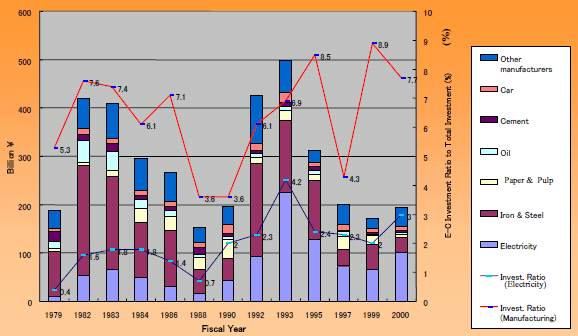|
Step 1
Enhancement of management, Improvement of
operation |
Step 2
Additional installation or improvement of
equipment |
Step 3
Change in process, Use of high-efficiency
equipment |
Rationalization of fuel
combustion |
* Control of air ratio, selection of suitable
burner
type for furnace and fuel species. Cleaning
of burners. Furnace pressure control. Prevention
of air entry, etc. |
* Combustion control through exhaust gas
analysis
* Installation of combustion control devices
* Adjustment of gas calorie |
* Low NOx burners, Regenerative burners
* Fluidized bed combustion
* Fuel change |
Rationalization of
heating/cooling
and heat
transfer |
* Optimization of seam pressure
* Cleaning the heating surface
* Improvement of heat patterns
* Improvement of methods of charging materials
to be heated |
* Extension of the preheating zone of industrial
furnaces, Reduction of heat capacity
* Improvement of control accuracy
* Additional installation of heat exchangers,
Use of
multiple effect
* Increasing the stages for the distillation
tower, Changing filling materials |
Omission of processes, Utilization of sensible
heat
in the preceding process (hot strip charge),
Re-
compression of steam, Improvement of catalyst
(PP,
exhaust gas treatment), Use of film, Changing
the
constituents (low-temperature paints, materials
that
do not require heat treatment), Heating by
infrared rays, Changing materials (use of
recycled paper and
water sediment), and jet heating |
Prevention of
heat loss through
radiation/heat
transfer |
* Optimization of the volume of boiler blow
water
* Reducing the radiation surface area and
standby
time
* Prevention of steam leaking portions, etc.
* Reinforcement of heat insulation, Reduction
of
opening areas |
* Continuous blow equipment
* Selection of steam traps
* Removal of unnecessary piping
* Spraying rock wool |
Reducing time by use of larger current for
electric
furnaces |
Recovery and
reuse of waste
energy |
Prevention of waste energy leaks |
* Closed recovery of condensate
* Anti-corrosive heat exchangers
* Heat pipe, Heat pumps |
* Power generation through recovery of low
to medium temperature waste heat, Power generation
through recovery of waste pressure, Recovery
of waste heat from solids (slag, sintered
ores , and
coke. CokeDry Quenching)
* Energy supply to parties outside the factory
(regional heating/cooling) |
Rationalization of conversion of
heat into motive
power, etc. |
* Optimization of extraction, Back steam
pressure
* Improvement of boiler turbine load distribution
* Variable pressure operation |
* Higher efficiency of turbine blades and
nozzles
* Rationalization of steam ejectors
* Recovery of motive power from vacuum steam |
* Higher temperatures/pressure of steam
* Combined heat and power supply (co-generation,
fuel cells)
.Combined cycle power generation, Improvement
of engine efficiency |
Rational use of
electricity |
* Switch-off or cutting down excess lighting,
funs, elevators etc.
* Optimization of operating numbers of funs,
pumps and compressors according to road
* Balancing among roads to each pumps |
* Valuable fluid mass control system (Inverter
control
system)
* Fluorescence lighting
* Power factor improving facilities (phase-sifting
condenser, reactor) |
* High efficiency motor, transformer
* Electricity recovery system of elevator,
crane
* High efficiency fluorescence lighting (inverter
control type) |

